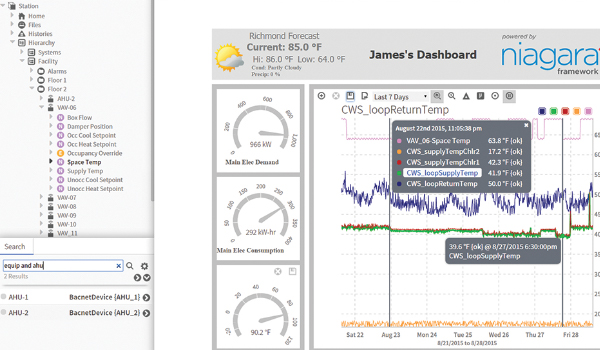
At the epicenter of Tridium change
Since he started at Tridium in 2001, Blake Puhak began tucking away a wish list of ideas: enhancements to Niagara release 2 and Niagara AX that, were he to ever get the opportunity, he would love to make. Other engineers had their own wish lists.
And then in 2013 came the vision from the top: a major update to Niagara, built on open web standards, and a mission to become a core technology running the global Internet of Things.
“The change between Niagara AX to Niagara 4 gave us a chance to break some things that we couldn’t break over the last ten years just because it would have screwed up our customers,” says Puhak, senior software engineer, age 36.
“Since it was such a major version shift, we had a chance to strip out and remove some dead APIs and rip out code and replace that with some new batteries, so to speak.”
And even with a laundry list of updates, “we probably didn’t change nearly as much as we’d like to.”
Niagara 4 was constructed concurrently with 3.8, splitting software teams between the two releases. Also at that time, the development process was transitioning from more traditional methodologies to a strict Agile approach. “As you can imagine, there were a lot of changes going on here,” says Puhak.
One of the biggest changes was to Niagara’s UI, which utilizes HTML5 to provide an array of rich features that make the user experience simpler and give users maximum control of their data and decisions. Users also no longer have to rely on using the Java applet on their desktop, and the framework, now open, means an entirely new class of developers can build on top of it.
With Niagara 4, Puhak says, developers don’t need to know the framework to write for it. “They just need to know standard Javascript and open-source technologies, so if a developer is already familiar with those methods, picking up Niagara becomes a lot easier for them, and the learning curve is a lot less,” he says, “especially if they’re focused on the UI side of things.”

Tridium is on the brink of major fundamental change also, as it moves its software and hardware to edge devices and the cloud. As part of that, users will have the ability to run Niagara on new, custom hardware devices beyond the JACE®.
“Whether that’s something along the line of JACE capabilities or edge capabilities, it will be really exciting to see how that plays out and how it affects what we do,” Puhak says. “I am sure there will still be a market for a general purpose controller like our JACE, but I think we’ll see a lot more specialty controllers out in the marketplace from our customers.”
Up next for Niagara
For Puhak, an ultra-marathoner and one of the veteran engineers at Tridium, his time is split between code-facing work and serving as a company face. He travels to recruiting events around the Mid-Atlantic, and, where he can, is helping architect the framework for edge development.

“While Niagara is centered around the building industry, we never really wrote it specifically for buildings,” he notes. “We really tried to write a general framework that would interface with anything.”
When he started at Tridium fresh out of the University of Richmond, Puhak’s role was driver development, a role that let him learn both the hardware and software side of the product and gave him the time to learn the ins and outs of the framework, which today has approximately 4 million lines of code.
“I’ve learned over the years that it takes even senior people a good six months to be really productive using the framework, and a junior developer could take double that just because of the sheer amount of code,” says Puhak. “You certainly don’t have to know [all of the code] or see it all, but there’s a lot to wrap your head around.”
Puhak has gained more responsibilities as time has gone on. He researched how to integrate release 2 into Niagara AX, and wrote the installer for Niagara AX. He rewrote the licensing server for machines running Niagara, which evolved into Niagara Central (now Niagara Community), an online portal for users to manage downloads, solve problems and join in the community.
He is also a regular speaker at the biannual Niagara Summit.
“Up on stage the first several times, it was just nerve-wracking; I’m an engineer so public speaking is not my forte, but I’ve actually started to enjoy that, and I don’t get nearly as nervous as I used to,” he says. But the real value at the Summits, he says, is getting face time with dedicated users.
“When you’re here in the office, the only customers you ever hear from are the ones coming through tech support where something’s gone wrong, but then you go to the Summit and you realize that even though there are always issues to be solved, that there are people who are passionate about Niagara and how it has changed their lives and industries,” Puhak says.
“We’re writing software that people are using every day and actually controlling their buildings and other things, and it’s saving people time and money—that’s pretty cool to me. It’s a great feeling.”
FINDING NIAGARA ON MARS
The coolest instance of Niagara, in Blake Puhak’s eyes?
Up on Mars, there’s a rover crawling around. No, Niagara isn’t on Mars, but it does monitor the cleanroom that the rover was built in. “The guy who did that installment, I met him maybe six years ago and we still stay in contact,” Puhak says.